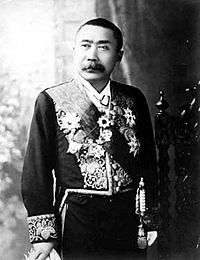Takahira Kogorō
Baron Takahira Kogorō KCMG (高平 小五郎, January 29, 1854 – November 28, 1926) was a Japanese diplomat and ambassador to the United States from 1900 to 1909.
Takahira Kogorō | |
|---|---|
 Baron Takahira Kogorō at the Louisiana Purchase Exposition in St. Louis in 1904 | |
| Born | January 29, 1854 |
| Died | November 28, 1926 (aged 72) |
| Nationality | Japan |
| Occupation | Politician, Diplomat |
Biography
Takahira was born in what is now Ichinoseki city, Iwate prefecture.[1] From relatively modest beginnings, Takahira was to become a graduate of Kaisei Gakkō (the predecessor to Tokyo Imperial University).
Career diplomat
In 1876, he joined the Ministry of Foreign Affairs. His first posting to the United States in 1879 was as an attaché; and he was promoted to secretary in 1881. During a return to Asia, he served briefly as chargé d'affaires in Korea and as Consul General in Shanghai, China. In 1887, he returned to the United States as Consul General in New York City. Postings in Europe as Minister-Resident to Netherlands and Denmark, and as Minister Plenipotentiary at Rome, Vienna and Bern spanned the years before his 1901 return to Washington, D.C. He then continued as Japan's minister in the United States from 1901 through 1905.[1]

Takahira participated in a number of important Japanese-US negotiations. Takahira was one of the principals of the Japanese delegation negotiating with the Russians to conclude the Treaty of Portsmouth, which ended the Russo-Japanese War.[2]
In 1907, Takahira was named Ambassador to Rome. The Foreign Ministry called him back to Washington, D.C. in 1908-1909.[1]
As principal negotiator for Japan, his name is commemorated in the 1908 Root-Takahira Agreement, which was intended to ease Japanese-US tension by defining each nation's role in the Pacific arena and China.[1]
Takahira later elevated to danshaku (baron) under the kazoku peerage system, and was appointed to the House of Peers, and subsequently served on the Privy Council.
Honors
- Order of the Sacred Treasure, Grand Cordon.[3]
| Wikimedia Commons has media related to Takahira Kogoro. |
- Hon. Knight Commander of the Order of St. Michael and St. George (KCMG) (20 February 1906)[4]
- Grand Cordon of the Order of the Rising Sun (1 April 1906)
Notes
- Takahira Kogoro. (1920). Encyclopedia Americana, p. 220.
- "Text of Treaty; Signed by the Emperor of Japan and Czar of Russia," New York Times. October 17, 1905.
- MacMurray, John Van Antwerp. (1921). Treaties and Agreements with and Concerning China, 1894-1919: A Collection, p. 522.
- The London Gazette, 15 May 1906
References
- Beasley, W.G. Japanese Imperialism 1894-1945. Oxford: Oxford University Press. ISBN 0-19-822168-1
- Davis, Richard Harding, and Alfred Thayer Mahan. (1905). The Russo-Japanese war; a photographic and descriptive review of the great conflict in the Far East, gathered from the reports, records, cable despatches, photographs, etc., etc., of Collier's war correspondents New York: P. F. Collier & Son. OCLC: 21581015
- Keene, Donald. (2002). Emperor Of Japan: Meiji And His World, 1852-1912. New York: Columbia University Press. ISBN 978-0-231-12340-2 (cloth) -- ISBN 0-231-12341-8
- Korostovetz, J.J. (1920). Pre-War Diplomacy The Russo-Japanese Problem. London: British Periodicals Limited.
- MacMurray, John Van Antwerp. (1921). Treaties and Agreements with and Concerning China, 1894-1919: A Collection. Oxford: Oxford University Press.
- Morris, Edmund. 92002). Theodore Rex. Modern Library; Reprint edition. ISBN 0-8129-6600-7